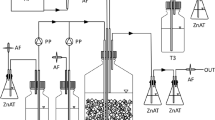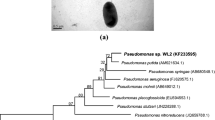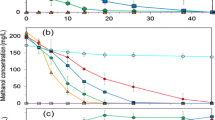Abstract
During experiments investigating the purification of waste gas a bacterium capable of using carbon disulphide (CS2) als sole energy source was isolated. It could be identified as a Thiobacillus sp.; however, the species remains unclear. Both the properties of T. thioparus and T. thiooxidans have been observed. Since the organism could be used for removing CS2 in the environment, the degradation kinetics have been investigated by different methods. Substrate concentrations of up to 100 mg CS2·l−1 were oxidized at maximum rates of 2.5 mg CS2·g−1 protein·min−1 at pH 7.0 and at 30°C. CS2 levels above 150 mg CS2·l−1 caused termination of degradative activity.
Similar content being viewed by others
References
Agate AD, Vishniac W (1973) Characterization of Thiobacillus species by gas-liquid chromatography of cellular fatty acids. Arch Mikrobiol 89:257–267
Bradford MM (1976) A rapid and sensitive method for the quantitation of microgram quantities of protein utilizing the principle of protein-dye binding. Anal Biochem 72:248–254
Bremner JM, Banwart WL (1976) Sorption of sulfur gases by soils. Soil Biol Biochem 8:79–83
DSM (1989) Catalogue of strains, 4th edn. DSM — Deutsche Sammlung von Mikroorganismen und Zellkulturen, Braunschweig
Grothaus H, Theis G, Freundt KJ (1982) Schwefelkohlenstoff. In: Bartholomé E, Biekert E, Hellmann H, Ley H, Weigert WM, Weise E (eds) Ullmanns Encyklopädie der technischen Chemie, vol 21, 4th edn. Verlag Chemie, Weinheim, pp 87–99
Harrison AP (1983) Genomic and physiological comparisons between heterophilic thiobacilli and Acidiphilium cryptum, Thiobacillus versutus sp. nov., and Thiobacillus acidophilus nom. rev. Int J Syst Bacteriol 33:211–217
Hewlett Packard (1989) Manual for the Hewlett Packard microbial identification system. Hewlett Packard, Palo Alto/USA
Kalmbach S, Schmölling J (1990) Technische Anleitung zur Reinhaltung der Luft, 3rd edn. Erich Schmidt, Berlin, p 42
Katayama-Fujimura Y, Tsuzaki N, Hirata A, Kuraishi H (1984) Polyhedral inclusion bodies (carboxysomes) in Thiobacillus species with reference to the taxonomy of the genus Thiobacillus. J Gen Appl Microbiol 30:211–222
Kelly DP (1988) Oxidation of sulphur compounds. Soc Gen Microbiol Symp 42:65–98
Kelly DP, Baker SC (1990) The organosulphur cycle: aerobic and anaerobic processes leading to turnover of C1-sulphur compounds. FEMS Microbiol Rev 87:241–246
Leithe W (1974) Die Analyse von Luft und ihren Verunreinigungen in der freien Atmosphäre und am Arbeitsplatz. Wissenschaftliche Verlagsgesellschaft, Stuttgart
Minami K, Fukushi S (1981) Detection of carbon disulfide among the gases produced by thiosulfate and tetrathionate addition to soils. Soil Sci Plant Nutr 27:541–543
Neumüller OA (1987) CS2. In: Falbe J, Regitz M (eds) Römpps Chemie-Lexikon, vol 5, 8th edn. Franckh'sche Verlagsbuchhandlung, Stuttgart, pp 3758–3759
Ottengraf SPP, Meesters JJP, Oever AHC van den, Rozema HR (1986) Biological elimination of volatile xenobiotic compounds in biofilters. Bioprocess Eng 1:61–69
Plas Ch, Wimmer K, Danner H, Harant H, Holubar P, Braun R (1991) Biologische Oxidation von Schwefelkohlenstoff durch ein Thiobacillus-Isolat. gwf Wasser-Abwasser 132:419–421
Plas Ch, Harant H, Danner H, Jelinek E, Wimmer K, Holubar P, Braun R (1992) Ratio of biological and chemical oxidation during the aerobic elimination of sulfide by colourless sulfur bacteria. Appl Microbiol Biotechnol 36:817–822
Rajagopal BS, Daniels L (1986) Investigations of mercaptans, organis sulfides, and inorganic sulfur compounds as sulfur sources for the growth of methanogenic bacteria. Curr Microbiol 14:137–144
Skerman VBD, McGowran V, Sneath PHA (1980) Approved lists of bacterial names. Int J Syst Bacteriol 30:225–420
Smith NA, Kelly DP (1988) Oxidation of carbon disulfide as the sole source of energy for the autotrophic growth of Thiobacillus thioparus strain TK-m. J Gen Microbiol 134:3041–3048
Sotoudeh M (1991) Anwendung verschiedener Korrelationen für den Stoffübergang auf den Tropfkörperreaktor zur Abluftreinigung der Glanzstoff Austria AG. Diploma thesis, Technocal University Vienna
Starkey RL (1935) Isolation or some bacteria which oxidize thiosulfate. Soil Sci 39:197–219
Waksman SA, Joffe JS (1921) Acid production by a new sulfur oxidizing bacterium. Science 53:216
Author information
Authors and Affiliations
Additional information
Correspondence to: Ch. Plas
Rights and permissions
About this article
Cite this article
Plas, C., Wimmer, K., Holubar, P. et al. Degradation of carbondisulphide by a Thiobacillus isolate. Appl Microbiol Biotechnol 38, 820–823 (1993). https://doi.org/10.1007/BF00167151
Received:
Accepted:
Issue Date:
DOI: https://doi.org/10.1007/BF00167151




